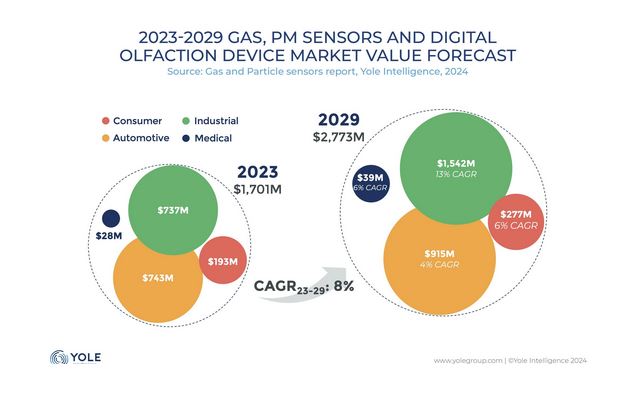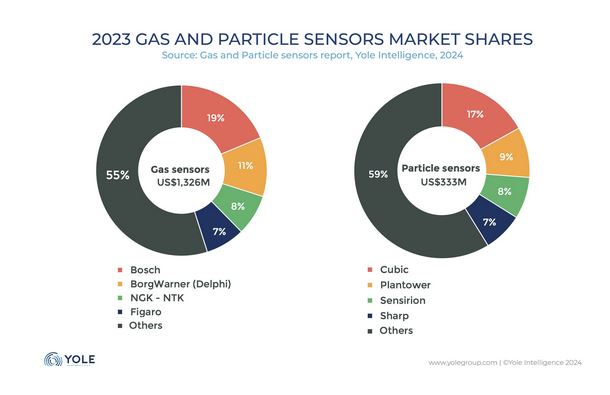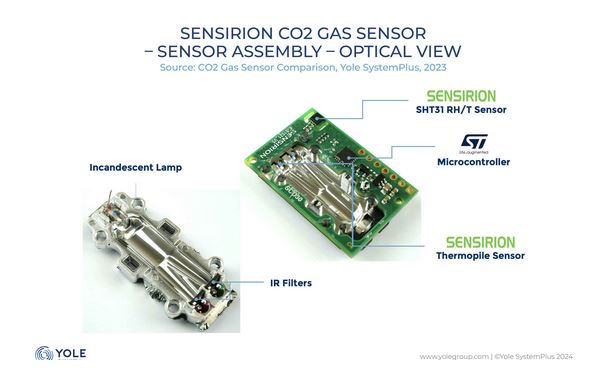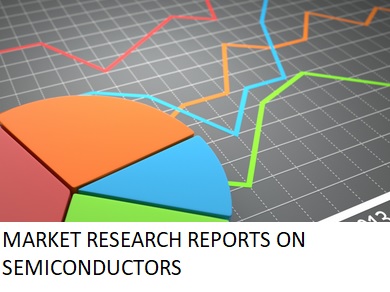Date: 05/02/2024
Gas sensor industry: are new opportunities in the air?
Supported by industrial and safety applications, the market continues to capitalize on opportunities in air quality monitoring.
OUTLINE
The gas and particle sensor market is expected to reach US$2.8 billion in 2029, with an estimated 8% CAGR from 2023 to 2029.
Bosch, BorgWarner, and NGK-NTK: the major share of the gas sensing industry is held by automotive players.
NDIR and MOX technologies are increasingly dominant in gas sensing for people safety, surpassing conventional technologies.
In recent years, heightened awareness of health and the environment has led to the development of various air quality monitors. This has fueled an 8% and 11% growth in the gas and particle sensor markets, respectively, between 2023 and 2029, culminating in an expected US$2.8 billion market in 2029. The digital olfaction sector, primarily focused on research and development products, is anticipated to reach US$52 million in 2029.
Pierre-Marie Visse, Senior Technology & Market Analyst, MEMS and Sensing at Yole Group said
"The industrial market dominates the revenue landscape for gas sensing, driven by legislation on refrigerant gas leak detection in HVAC and AC systems, as well as ASHRAE regulations. The automotive market is the second largest by revenue, where gas and PM are sensors used for powertrain management, HVAC system management and thermal runaway detection in EV s. In third position is the consumer market, driven by the demand for air purifiers.”
The recent surge in global energy costs, prompted by geopolitical conflicts, has spurred interest in alternative energy sources, such as hydrogen. This gas is a potential primary energy source for various industrial and residential applications.
Looking ahead, the medical market is expected to remain relatively stable, with gas sensors finding applications in capnography and breath analyzer devices.
In this context, Yole Group releases its market & technology report Gas and Particle Sensors 2024. In this report, the company provides the latest updates on gas and PM sensors, as well as digital olfaction solution volumes and revenues for 2023. It gives an overview of the best growth opportunities and key market drivers for these sensors. With this new study, Yole Group offers a detailed view of the ecosystem regarding developments and funding and a broad overview of the technology trends.
Furthermore, to highlight the growing interest in the CO2 gas sensors market, Yole Group has conducted a comprehensive comparative analysis of five CO2 gas sensors. Yole Group’s analysts examine technologies, supply chains, and costs in the CO2 Gas Sensor Comparison 2023 report. The products evaluated are sourced from key market suppliers, such as Sensirion, Amphenol, and Cubic Sensor, representing Single- and Dual-Beam NDIR CO2 sensors, photoacoustic, and thermo-conductive technologies.
Both Yole Group’s analyses provide up-to-date comprehensive overviews of the industry and the competitive landscape.


Khrystyna Kruk, Technology & Cost Analyst, MEMS & Sensing at Yole Group said “Despite the established dominance of NDIR technology in the current market, we can anticipate a potential shift towards photoacoustic sensors, propelled by their considerable advantages in terms of size and cost.”
The push for miniaturization and low power consumption has led NDIR and MOX technologies to gain market share.
Pierre Delbos, Technology & Market Analyst, MEMS & Sensing at Yole Group said “Post-COVID-19, gas-sensing players are venturing into gas monitoring, but the lack of legislation, standardized performance metrics, and data representation methods leave consumers perplexed. This uncertainty has contributed to the consumer market remaining relatively stable since the pandemic,”
The gas sensing sector remains dynamic, as is evident from the continuous release of new products featuring PAS or NDIR technology and multi-gas sensors based on MOX technology. Cubic Sensor takes the lead in particle sensing, while an increasing number of Chinese companies are providing cost-effective solutions for consumer applications.
The digital olfaction ecosystem is still emerging, with notable fundraising activities amounting to US$64 million observed in recent years.
Yole Group’s MEMS and sensing team invites you to follow the technologies, related devices, applications, and markets on www.yolegroup.com.
Source: Yole
Tweet Follow @ecewire

